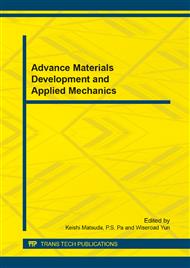[1]
S. Saeki, Y. Matsushima, K. Hachisuka, Cortical activation during robotic therapy for a severely affected arm in a chronic stroke patient: a case report, J. UOEH, vol. 30, no. 2, p.159–165, (2008).
DOI: 10.7888/juoeh.30.159
Google Scholar
[2]
G.B. Prange, M.J.A. Jannink, C.G.M. Groothuis-Oudshoon, H.J. Hermens, M.J. IJzerman, Systematic review of the effect of robot-aided therapy on recovery of the hemiparetic arm after stroke, J. Rehabil Res Dev, vol. 43, p.171–184, (2006).
DOI: 10.1682/jrrd.2005.04.0076
Google Scholar
[3]
H.I. Krebs, N. Hogan, B.T. Volpe, M.L. Aisen, L. Edelstein, C. Diels, Overview of clinical trials with MIT-MANUS: A robot-aided neuro-rehabilitation facility, Technol. Health Care, vol. 7, p.419–423, (1999).
DOI: 10.3233/thc-1999-7606
Google Scholar
[4]
C.G. Burgur, P.S. Lum, P.C. Shor, H.F. Machiel Van der Loos, Development of robots for rehabilitation therapy: The Palo Alto VA/Standard experience, J. Rehabil. Res. Dev., vol. 37, p.376–388, (2000).
Google Scholar
[5]
S. Masiero, A. Celia, G. Rosati, M. Armani, Robotic-assisted rehabilitation of the upper limb after acute stroke, Arch. Phys. Med. Rehabil., vol. 88, p.142–149, (2007).
DOI: 10.1016/j.apmr.2006.10.032
Google Scholar
[6]
S. Hesse, G. Schulte-Tiggers, M. Konrad, M.A. Bardeleben, C. Werner, Robot-assisted arm trainer for the passive and active practice of bilateral forearm and wrist movements in hemiparetic subjects, Arch. Phys. Med. Rehabil., vol. 84, pp.915-920, (2003).
DOI: 10.1016/s0003-9993(02)04954-7
Google Scholar
[7]
S. Hesse, C. Werner, M. Pohl, S. Rueckriem, J. Mehrholz, M.L. Lingnau, Computerized arm training improves the motor control of the severely affected arm after stroke: a single-blinded randomized trial in two centers, Stroke, vol. 36, pp.1960-1966, (2005).
DOI: 10.1161/01.str.0000177865.37334.ce
Google Scholar
[8]
M. Ferraro, J.J. Palazzolo, J. Krol, H.I. Krebs, N. Hogan, B.T. Volpe, Robot-aided sensorimotor arm training improves outcome in patients with chronic stroke, Neurology, vol. 61, pp.1604-1607, (2003).
DOI: 10.1212/01.wnl.0000095963.00970.68
Google Scholar
[9]
Guan De Lee, Wei-Wen Wang, Kai-Wen Lee, Sheng-Yen Lin, Li-Chen Fu, Jin-Shin S. Lai, Wen-Shiang Chen, Jer-Junn J. Luh, Arm exoskeleton rehabilitation robot with assistive system for patient after stroke, Proc. of ICCAS, pp.1943-1948, (2012).
DOI: 10.1109/memea.2013.6549717
Google Scholar
[10]
Hong-Bo B. Wang, Ning Du, Huina Hou, Jiangshun Zhao, Hongnain N. Yu, An upper limb rehabilitation robot based on 3-RRC parallel mechanism, Proc. of ICAMechS, pp.668-673, (2012).
Google Scholar
[11]
Xikai Tu, Jian Huang, Liguo Yu, Qi Xu, Jiping He, Design of a wearable rehabilitation robot integrated with functional electrical stimulation, Proc. of IEEE RAS & EMBS BioRob, pp.1555-1560, (2012).
DOI: 10.1109/biorob.2012.6290720
Google Scholar
[12]
Lei Shi, Kun Jiang, Qiang Wang, Zhen Liu, A New Method of Quantitative Rehabilitation Rating in Robot-Assisted Recovery System, Proc. of ICINIS, pp.278-281, (2012).
Google Scholar
[13]
Yongsuk Kang, Doyoung Jeon, Rehabilitation robot control using the VSD method, Proc. of SII, pp.192-197, (2012).
DOI: 10.1109/sii.2012.6427313
Google Scholar
[14]
Chao Lv, Le Xie, Wei Shao, Hai-long Yu, Yuan Wang, Jin-wu Wang, Ning Nan, Development of a Rehabilitation Robot for Upper-Limb Movements, Intelligent Robotics and Applications, Lecture Notes in Computer Science, Vol. 7507, pp.96-102, (2012).
DOI: 10.1007/978-3-642-33515-0_10
Google Scholar
[15]
I. Yamamoto, N. Inagawa, K. Hachisuka, et al., Development of compact rehabilitation robot for a wrist using biological signal, Proc. of IEEE CME, pp.557-560, (2012).
DOI: 10.1109/iccme.2012.6275703
Google Scholar
[16]
I. Yamamoto, N. Inagawa, K. Hachisuka, F. Wada, A. Hachisuka, Development of a Rehabilitative Training Robot for Both Wrists, Proc. of 2013 ICME, pp.280-284, (2013).
DOI: 10.1109/iccme.2013.6548255
Google Scholar
[17]
I. Yamamoto, N. Inagawa, M. Matsui, K. Hachisuka, F. Wada, A. Hachisuka, Research and Development of Compact Wrist Rehabilitation Robot System, Bio-Medical Materials and Engineering 24, pp.123-128, (2014).
DOI: 10.3233/bme-130792
Google Scholar


